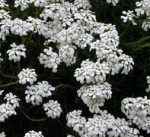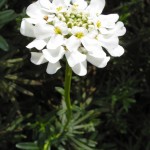 Candytuft is a woody-based herbaceous perennial native to southern Europe and a member of the cabbage family, Brassicaceae, that also includes mustard, broccoli, and Alyssum. The fine dark green leathery leaves are 1-1.5″ long and form a mound 6-12″ tall that is attractive the entire growing season in warm climates. In summer, small white 4-petaled flowers appear in dense flattened clusters and gradually may fade to light pink. Candytuft is an excellent choice for a rockgarden or edging plant and will spill down over rocks or walls with a blanket of white flowers for several weeks in the spring. It also does well as a cut flower, with a vase life of 5 to 6 days in cool temperatures. The seed heads are attractive in dried arrangements. The genus name, Iberis, is the Greek name for the Ebros River and indicates that the plant is from the Iberian peninsula. The specific epithet, sempervirens, is from the Latin words semper meaning always, and virens meaning green, and refers to the foliage.
Candytuft is a woody-based herbaceous perennial native to southern Europe and a member of the cabbage family, Brassicaceae, that also includes mustard, broccoli, and Alyssum. The fine dark green leathery leaves are 1-1.5″ long and form a mound 6-12″ tall that is attractive the entire growing season in warm climates. In summer, small white 4-petaled flowers appear in dense flattened clusters and gradually may fade to light pink. Candytuft is an excellent choice for a rockgarden or edging plant and will spill down over rocks or walls with a blanket of white flowers for several weeks in the spring. It also does well as a cut flower, with a vase life of 5 to 6 days in cool temperatures. The seed heads are attractive in dried arrangements. The genus name, Iberis, is the Greek name for the Ebros River and indicates that the plant is from the Iberian peninsula. The specific epithet, sempervirens, is from the Latin words semper meaning always, and virens meaning green, and refers to the foliage.
Type: Herbaceous perennial.
Bloom: White; late spring .
Size: 10″H x 18″ W.
Light: Sun.
Soil: well drained; average fertility; pH 6.6 to 7.1.
Fertilizer: Feed monthly during the growing season with a high phosphorus fertilizer.
Hardiness: USDA zones 3-8 ; AHS Zones 9-1.

Care: Prune back the foliage by 1/3 immediately after flowering to keep a compact appearance and remove unattractive seed pods.. May need some protection in USDA Zone 4 or colder.
Pests and Diseases: No serious pest problems. Crown rot may occur if the soil is too wet; crown rot and club root may occur with age.
Propagation: Propagated by rooted stem cuttings, crown division, or seeds.
Companion plants: Spring bulbs.
Outstanding Selections: ‘Purity” produces abundant flowers; ‘Autumn Snow” blooms heavily in spring and repeats in autumn.

My Candytuff appears to be diseased and leaves seem to be thinning. I am in Zone 7 (Virginia) and it is now July. Typically the prunging would be shortly after the flowering in the Spring. However I am wondering if it is advisable to prune back this time of the year to see if new growth would rid me of the problems I am having? If so how far back should I prune them?
Thanks
Ken
Ken,
Sorry to hear that your candytuft is doing poorly. It is generally a carefree plant but I have had a similar problem and lost one this year. The main cause of candytuft demise is wet soil that causes a rotting of the root. With the huge amount of rain we had this spring in zone 7, that may be the cause of your plant’s decline. Cutting the plant back by 1/3-1/2 might help. Also, give it some lime if you soil tends to be acid. Candytuft likes slightly alkaline soil (although usually tolerates almost any pH). Hope this helps.